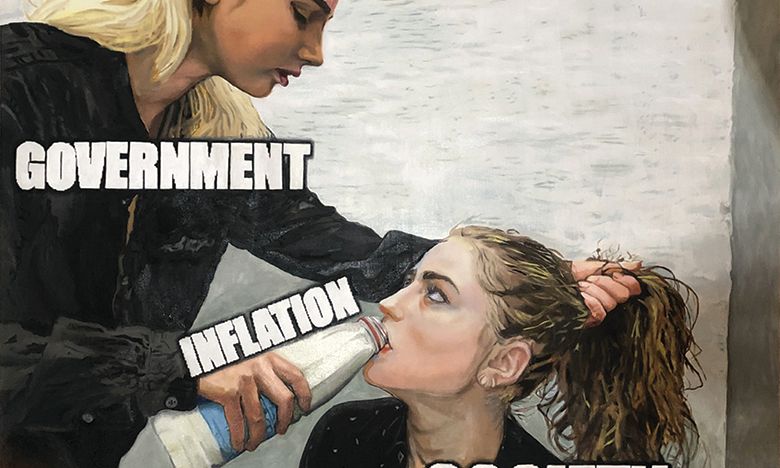Christine Wang’s Drinking Milk (2021) will be on show at Galerie Nagel Draxler from Germany, which can now attend the fair after the US lifted its travel ban.
The Mayor of Miami and technophile, Francis Suarez, recently announced that he will take his next salary in bitcoin and has been on a Twitter charm offensive to encourage young, successful techies to move to the tax-friendly Sunshine State. To some degree it has worked and, helped by Florida’s warm climate and relatively relaxed lockdown, Miami’s reputation as a retirees’ haven has taken a youthful turn.
Marc Spiegler—Art Basel’s global director and the interim head of Art Basel in Miami Beach (ABMB, 2-5 December) until a new director of the Americas is appointed to replace Noah Horowitz—is hoping this new affluent tech community will find their way to the fair this month. “Now they just have to jump in an Uber; before, they had to get in a plane,” he says. Playing to the audience, Art Basel has partnered with the blockchain Tezos to present a “curated NFT art experience”, incorporating an exhibition, AI generated self-portraits to take away as an NFT and talks, within the fair.
Out of 254 exhibitors, ABMB 2021 has 43 galleries exhibiting for the first time—more than usual, but Spiegler says it is a “natural evolution”, responding to “changes in the global art scene” over the course of the pandemic. “The art world traditionally hasn’t had many galleries that were owned by people of colour, but one of the things we noticed over the past year-and-a-half was that more such galleries are emerging,” Spiegler says. In order to diversify its own predominantly white exhibitor base, Art Basel has relaxed its previous application rules that required exhibitors to have been established for three years and to have a permanent gallery space.
Growing diversity
ABMB’s Nova section this year welcomes two New York-based galleries owned by Black women, neither of which would have previously qualified for entry: Kendra Jayne Patrick (who does not have a permanent gallery space) and Nicola Vassell, who works with various collectors including Swizz Beatz but only started her own gallery this year. Art Basel has also made efforts to broaden its outlook, so Spiegler says, “another new exhibitor is Welancora Gallery from Brooklyn, which is also owned by a woman of colour (Ivy N. Jones) and wasn’t really on our radar previously.” There is also a rise in Africa-based galleries—for example, First Floor from Zimbabwe, Rele Gallery from Nigeria and Afriart from Uganda.
So ABMB visitors can expect, in Spiegler’s words, an exhibitor profile that is “still too white, but not as white as it was.” He adds: “The structural racism that has kept many people of colour from opening galleries will take time to change.”
On a more practical level, the Meridians section for large-scale works, introduced in 2019, will be moved into the main fair—and away from the garish carpet of the Miami Beach Convention Center’s Grand Ballroom. The floorplan had to be entirely redone after 32 galleries that had previously bowed out this year decided to participate after the US announced it would relax travel restrictions for vaccinated visitors from 33 countries—including the UK, China and most of Europe—begining in November, prompting a flood of enquiries from galleries in late September.
Among them was The Modern Institute from Glasgow. “We pulled out at the last point possible (8 September), and then re-joined at the first possible moment,” says Toby Webster, the gallery’s director. “For us, it’s a really important fair and Americans are one of our biggest clients, but we haven’t been able to go to the US since March 2020.”
Physical connection
Axel Dibie, the owner and director of Paris-based Crèvecœur, also cancelled due to travel restrictions and backtracked in September: “In the pre-post-Covid era, when art fairs are resuming in real life, we feel a strong need to connect physically with the works, to meet in person and to be able to talk about art.” While online platforms have improved, Dibie believes “that the gallery model relies on physical interaction”.
Galerie Nagel Draxler from Germany also did a U-turn. “Miami is such a lively place and fair, and it is absolutely important for us to be there physically to meet our clients and discuss the art, so a ‘ghost booth’ would not have been an option for us,” its co-founder Saskia Draxler says. She adds: “Miami recently became home to a lot of crypto aristocracy, so we think this year’s fair will see a lot of activity around the subject and NFTs.” The gallery will therefore dedicate half of its stand “to artists that engage with blockchain technology and NFTs, such as Kevin Abosch, Theo Triantafyllidis and Sarah Friend”.
• Art Basel in Miami Beach, Miami Beach Convention Center, 2-5 December

